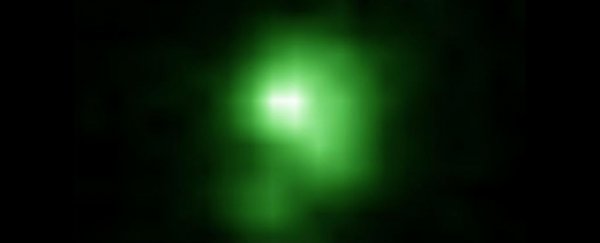There's a puzzling mystery surrounding the Universe's early evolution: after the Big Bang, the Universe cooled down for a billion years before somehow reheating in a period known as cosmic reionisation. Now an international team of scientists thinks they might have found the hidden catalyst.
The researchers believe that 'green pea' galaxies - so-called because of the way they appear on the Sloan Digital Sky Survey (SDSS) - caused a huge boost in fresh energy for our young cosmos, kicking out new stars and galaxies in a similar way to the original Big Bang. These newly formed dwarf galaxies weren't actually discovered until 2007, when volunteers studying deep space photos began to notice their existence.
The new hypothesis came about after the study of 5,000 green pea galaxies through the data provided by the SDSS. Five were chosen for further examination with the Hubble Space Telescope and one of them - the innocuously named J0925+1403 - was found to be actively ejecting photons capable of ionising hydrogen. Until now, all observed galaxies were only slowly leaking these photons at a rate easily absorbed by the surrounding gas and dust.
This hydrogen ionisation would fit with the pattern of cosmic reheating we mentioned earlier: namely the splitting apart of electrons and protons previously joined in hydrogen atoms, providing a fresh burst of energy for the surrounding Universe. It was already thought that existing galaxies had caused this second wave of transformation and the newly discovered evidence supports this theory.
"This galaxy appears to be an excellent local analog of the numerous dwarf galaxies thought to be responsible for the reionisation of the early Universe," said University of Virginia astronomer, Trinh Thuan, who led the research. "The finding is significant because it gives us a good place to look for probing the reionisation phenomenon, which took place early in the formation of the Universe that became the Universe we have today."
There's more investigating to be done, but the find gives scientists a good starting point as they try to figure out how these green pea galaxies may have kick-started a second and smaller Big Bang. It's hoped that the James Webb Space Telescope, due to come online in 2018, will allow astronomers to study these galaxies in even more detail.
"We expect to gain a much better understanding of the way photons are ejected from this type of galaxy, and the specific galaxy types driving cosmic reionisation," said Trinh. "These are crucial observations in the process of stepping back in time to the early Universe."
The group's work has been published in the journal Nature.
